The landscape of digital photography has experienced a seismic shift with the introduction of artificial intelligence (AI) tools, particularly by tech giant Google through applications like Google Photos. The recent decision to implement a new disclosure feature indicating when a photo has been edited with AI technologies—such as Magic Editor, Magic Eraser, and Zoom Enhance—signifies an important step towards transparency. However, this change raises significant questions about the efficacy and visibility of these disclosures, as well as the implications for users and the broader internet community.
Starting next week, users will encounter this AI editing disclosure at the bottom of the “Details” section when viewing edited photos. Google emphasizes that the purpose of this feature is to enhance transparency regarding the usage of AI in photo editing. Nevertheless, many users are likely to overlook this subtle addition because it fails to provide an immediate visual cue within the photo frame itself. In a world inundated with content, viewers often scroll quickly, and few pause to scrutinize the details behind an image. This raises a critical concern: is this new approach genuinely effective in conveying information about photo authenticity?
Despite Google’s intentions, the absence of a clear visual watermark remains a significant flaw. The reality is that even with metadata disclosures, the majority of users engage with images in a cursory manner. Less than rigorous examination of an image’s details may obfuscate the distinction between a digitally altered photo and a genuine capture. This lack of discernibility contributes to the ongoing debate about authenticity in an era where AI’s capabilities blur the lines between reality and illusion.
Furthermore, even if Google were to implement visual watermarks, it presents a unique set of challenges. Watermarks can be easily edited or cropped out by users, thereby nullifying their intended purpose of signaling authenticity. Therefore, while Google advances its stance on transparency, it must confront a more profound issue: how to effectively communicate the origins and modifications of images in an environment that often prioritizes speed and superficial interaction.
Google’s initiative follows criticism over releasing AI editing tools without transparent guidelines or signals for users about the authenticity of the images they encounter. It appears this response is motivated by a growing awareness that the rapid proliferation of AI image-editing technology could lead to widespread misinformation. Users must be informed not only about the edits made to their photos but also about the potential implications of encountering AI-altered images on social media, chat platforms, and across internet spaces.
In addressing concerns related to Google Photos’ new features like Best Take and Add Me, it’s noteworthy that while they will also have updated metadata disclosures, these solutions do not delve deeply enough into user transparency. The improvements might help in situations where metadata is accessed; however, they do not contribute to a tangible solution that empowers everyday users encountering these edited images online.
As AI technology gains traction, a growing emphasis on digital literacy becomes increasingly important. Users must develop an understanding of how AI image editing works and recognize the implications of encountering edited content. While platforms like Meta have taken steps to label AI-generated content on their platforms, others lag in adoption. Google has plans to incorporate AI content flagging in its search engine, but amidst fragmented systems, users remain vulnerable to misinformation.
While Google Photos’ new disclosure mechanism is a step towards addressing transparency in AI-enhanced photography, it ultimately highlights the inadequacy of simple metadata solutions. The challenge lies not just in informing users but in evolving the entire ecosystem of digital content to prioritize transparency and authenticity. For users in this rapidly shifting landscape, it is essential to remain vigilant, critically assessing the content they engage with and advocating for stronger disclosure practices that transcend mere metadata. Achieving true transparency in the age of AI requires a concerted effort across all platforms to redefine how we perceive and interact with digital imagery.

